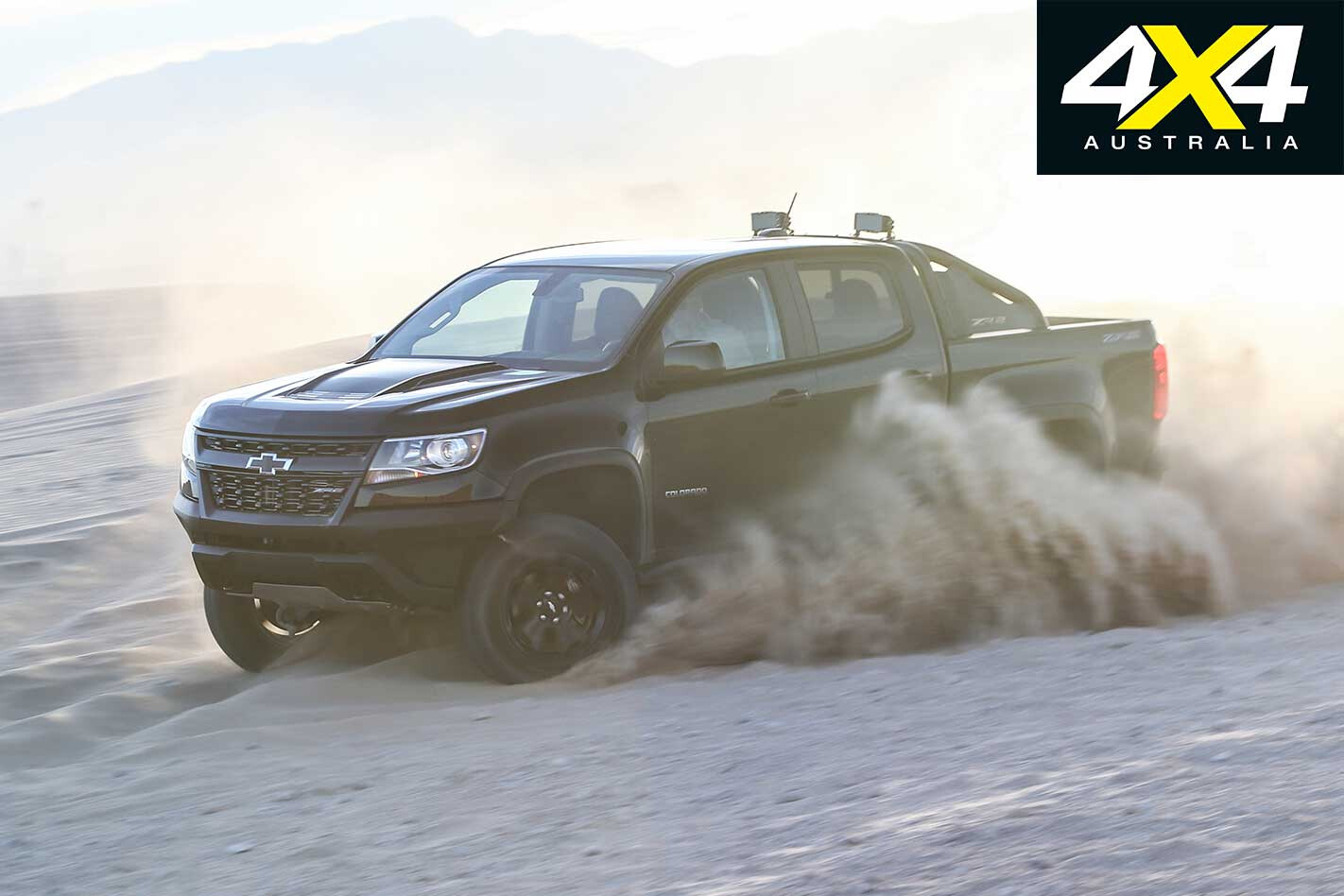The 2010 Ford SVT Raptor has a lot to answer for, and we should all be thankful for it. This factory-built pre-runner was the precursor to the current F150 Raptor from Ford Performance and was the inspiration for the Ranger Raptor that was developed here in Australia.
Not only has it spawned a small family of Raptors, but competing auto manufacturers couldn’t ignore the success of this high-performance off-road pick-up truck, and we’ve seen a few similar-themed vehicles from other companies.

The Blue Oval’s chief protagonist in Detroit, General Motors, took note of the Raptor’s sales and developed its own version wearing a Chevrolet bowtie badge, but rather than apply it to the full-size truck as per the Ford F150, it chose the mid-size Chevy Colorado to receive the makeover. This makes it a prime competitor to the Ranger Raptor, so we took the chance to drive one on a recent trip to the USA.
The Chevrolet Colorado ZR2 (that’s Zee-Arr-Two to the ’Muricans) follows the Raptor’s lead in being a pick-up with superior off-road capability than the regular model, and that added capability is directed toward higher speed, rough-road travel than, say, low-speed rock crawling or mud plugging. Think desert racing and the pre-runner vehicles used by race teams and you’re on the right track.
High-quality suspension is the key to superior vehicle control when traversing the roughest terrain at speed. Check out the online videos of Trophy Trucks smashing across the deserts of the USA, Mexico or Finke and you’ll see what a well set-up suspension system is capable of.

Look closer and you’ll find that the suspension on these trucks costs around $10K per corner and the shocks are so huge and complex that they would never fit into a production car. Companies like King and Fox make applications for production cars, but they are far simpler, smaller and considerably cheaper than the competition units. In fact, Ford Performance uses Fox suspension in both of its Raptor vehicles.
The shock absorbers in the ZR2 were also developed in motorsport, but it’s not the kind of racing you would expect to have anything to do with getting dirty. The DSSV (Spool Valve) shocks in the ZR2 are descendants of those used in Formula 1 less than 10 years ago and have more recently been found in top-end, road-going sports cars.
Chevrolet worked with the company that makes DSSV dampers, Multimatic Engineering, to re-engineer the technology for off-road applications, and the Colorado is the first vehicle we’ve seen them on. If the rumours are true, we’ll soon see them on an off-road focused Silverado full-size truck as well.

The Chevrolet Colorado is not the same truck as our Holden Colorado. It’s made in the US for the US market, while ours is made in Thailand for Asian and other markets. They might share some styling and design elements and the basic, ladder-frame, leaf-sprung, live axle rear and IFS construction, but they are built on a different chassis and the US model is slightly bigger all around. So don’t go out and buy a set of DSSV shocks for your Holden Colorado and expect them to bolt right in; although, we’d tip that they wouldn’t be far off.
HSV tells us it looked at the DSSVs for the SportsCat, but elected not to fit them for they “felt the SupaShocks delivered the best balance of performance and comfort, especially as a key program driver (in addition to off-road competency) was to also offer an outstanding on-road drive experience”.

That said, the DSSVs in the ZR2 deliver a great on-road ride and excellent ride and control off-road. Unlike the Fox suspension in the Ranger Raptor, which is soft and supple on-road, the Multimatics are taught and firm, giving flat cornering and a nice on-road ride.
Then when you get off the highway they cope with bumps and jumps with the confidence of a desert racer, soaking up any jolts and maintaining composure across the most arduous terrain. The faster you drive on them, the better they feel. It’s almost like they are taunting the driver to go harder with an, ‘is that all you’ve got?’ attitude.
To say the suspension package in the ZR2 gives the driver the best of both worlds when driving on- and off-road sounds too good to be true, but it delivers on this promise and doesn’t disappoint.
To help get the job done the ZR2’s suspension gains 50mm in height over a standard Colorado. It also features an 89mm-wider wheel track and locking differentials front and rear.

Tyre size is up over stock, too, but the 31-inch Goodyear Wranglers could be taller for added clearance over the 255mm available and to fill those pumped ’guards. There’s also extra underbody protection in the form of metal skid plates, plus chunky rock sliders to protect the sills.
The ZR2 comes with the Autotrac transfer case, which offers two-wheel drive (rear), Auto 4×4, 4×4 high range and 4×4 low range. With the Auto 4×4 mode you can leave the vehicle in 4×4 over all terrain, which is great on gravel roads and sandy tracks.

However, we found it could be slow to lock the drive to both axles, allowing unwanted tyre slip – locked 4×4 high was the best for desert travel. An off-road button optimises the chassis electronics, throttle and transmission settings for off-road driving.
As opposed to our Holden Colorado here or its local Toyota Tacoma and Ford Ranger competitors in the home market, the Chevy Colorado is available with a choice of petrol or diesel engines in the USA and both are offered in ZR2 spec. The diesel engine option is the 2.8-litre Duramax that Australians are familiar with, while the petrol engine as fitted to our test vehicle is a 230kW 3.6-litre V6.
The V6 is punchy but no powerhouse, and it matches well to the GM eight-speed auto. As expected, it is nowhere near as economical on fuel as the Duramax and our week-long mix of on- and off-highway travel netted 16.6L/100km.

Interestingly, Chevrolet only quotes 12.8L/100km highway mileage for the diesel ZR2. We have achieved far better from a Holden Colorado LTZ back home, but you must take in the ZR2’s higher ride height, extra frontal area and heavier, off-road focused tyres into consideration.
Chevrolet really ups the ante in the looks department for the ZR2, with its aggressive stance and body kit including a shortened front bumper, bonnet bulge, blacked-out grille, black alloy wheels and sports bar with LED driving lights.
One piece of kit that is a nice idea but isn’t well-executed is the bed-mounted spare wheel and tyre, which massively limits your cargo space and is mounted too far forward in the bed for ease of access should you need it.

The interior feels that little bit bigger than our Holden Colorado, and the centre stack and connectivity would be familiar to most modern Holden drivers. The ZR2 is well-appointed with leather seats, a quality sound system and all the features you expect of a high-end truck. With a starting price of US$40,390, the ZR2 is a high-end truck.
The Colorado ZR2 would be a worthy competitor to the Ranger Raptor and begs this question of Holden: when is it going to give us a better performing ute in Australia? Sure, there’s the Holden Colorado-based SportsCat from HSV, but a full factory-built vehicle would be more appealing.
We all know Holden needs something to light a fire under its new vehicle sales. The Raptor might have the edge over the ZR2 in dealing with outright desert dashing, but the Chevy would better the Ford in onroad dynamics and handling, thus giving it a broader spread of performance.

2018 CHEVROLET COLORADO ZR2 SPECS: Engine: 3.6L Petrol V6, DOHC, alloy block and heads Max power: 230kW at 6800rpm Max torque: 373Nm at 4000rpm Transmission: 8-speed automatic Construction: 4-door cab and cargo tub on ladder-frame chassis Front suspension: IFS with coil springs and DSSV shocks Rear suspension: Live axle with leaf springs and DSSV shocks Wheel and tyre: 17 x 8-inch alloys with 31-inch A/T tyres Kerb weight: 2160kg GVM: 2722kg Payload: 500kg Towing capacity: 2267kg Seating capacity: 5 Fuel tank capacity: 80L On-test fuel consumption: 16.6L/100km
Performance to the people

Our USA trip took us to the SEMA Show, where Chevrolet Performance announced a range of ZR2 suspension components – based on the Multimatic dampers – would be available to purchase to racers and builders for off-road use.
The performance kit was developed by Hall Racing, whose driver Chad Hall piloted a Colorado ZR2 equipped with these components throughout the 2017 and 2018 racing seasons, completing every mile of every race in the ‘Best in the Desert’ series. Hall Racing also used the Colorado ZR2 to pre-run the Baja 1000 race.
The race kit includes long travel DSSV shocks for front and rear, matching front coil springs and rear leafs, high-angle upper control arms with special ball joints, hydraulic bump stops, tie-rod sleeves for extra strength, tougher steel drive shafts and a body lift kit.
The parts are available as a kit or separately and can be fitted to ZR2 or regular Chevrolet Colorados for off-road use. We wonder how hard they’d be to fit to a Holden Colorado.






